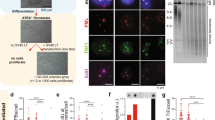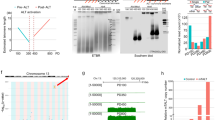Abstract
In human somatic cells proliferation results in telomere shortening due to the end replication problem and the absence of adequate levels of telomerase activity. The progressive loss of telomeric DNA has been associated with replicative senescence. Maintenance of telomere structure and function is, therefore, an essential requisite for cells that proliferate indefinitely. Human cells that have acquired the immortal phenotype mostly rely on telomerase to compensate for telomere shortening with cell division. However, a certain percentage of immortalized cell lines and human tumors maintain their telomeres by Alternative Lengthening of Telomeres (ALT), a mechanism not fully understood but apparently based on homologous recombination. Here, we report the isolation of an immortal human cell line that is derived from an ALT cell line but maintains telomeres in the absence of key features of ALT and of telomerase. The properties of these cells suggest that the identification of ALT cells may not be reliably based on known ALT markers. This finding is of relevance for discriminating between the mortal and immortal phenotype among telomerase-negative cells in vitro and in vivo, particularly in regard to the development of pharmacological approaches for cancer treatment based on telomerase inhibition.
This is a preview of subscription content, access via your institution
Access options
Subscribe to this journal
Receive 50 print issues and online access
$259.00 per year
only $5.18 per issue
Buy this article
- Purchase on Springer Link
- Instant access to full article PDF
Prices may be subject to local taxes which are calculated during checkout







Similar content being viewed by others
References
Armbruster BN, Banik SSR, Guo C, Smith AC and Counter CM . (2001). Mol. Cell. Biol., 21, 7775–7786.
Bacchetti S and Counter CM . (1995). Int. J. Oncol., 7, 423–432.
Bailey SM, Brenneman MA and Goodwin EH . (2004a). Nucleic Acids Res., 32, 3743–3751.
Bailey SM, Goodwin EH and Cornforth MN . (2004b). Cytogenet. Genome. Res., 107, 14–17.
Beattie TL, Zhou W, Robinson MO and Harrington L . (1998). Curr. Biol., 8, 177–180.
Bechter OE, Zou Y, Walker W, Wright WE and Shay JW . (2004). Cancer Res., 64, 3444–3451.
Bryan TM, Englezou A, Dalla Pozza L, Dunham MA and Reddel RR . (1997a). Nat. Med., 3, 1271–1274.
Bryan TM, Englezou A, Gupta J, Bacchetti S and Reddel RR . (1995). EMBO J., 14, 4240–4248.
Bryan TM, Marusic L, Bacchetti S, Namba M and Reddel RR . (1997b). Hum. Mol. Genet., 6, 921–926.
Bryan TM and Reddel RR . (1997). Eur. J. Cancer, 33, 767–773.
Cerone MA, Londoño-Vallejo JA and Bacchetti S . (2001). Hum. Mol. Genet., 10, 1945–1952.
Cesare AJ and Griffith JD . (2004). Mol. Cell. Biol., 24, 9948–9957.
Chen Q, Ijpma A and Greider CW . (2001). Mol. Cell. Biol., 21, 1819–1827.
Chute I, Le Y, Ashley T and Dobson MJ . (1997). Genomics, 46, 51–60.
Collins K . (2000). Curr. Opin. Cell. Biol., 12, 378–383.
Cornforth MN and Eberle RL . (2001). Mutagenesis, 16, 85–89.
Counter CM, Avilion AA, LeFeuvre CE, Stewart NG, Greider CW, Harley CB and Bacchetti S . (1992). EMBO J., 11, 1921–1929.
Counter CM, Hahn WC, Wei W, Dickinson Caddle S, Beijersbergen RL, Lansdorp PM, Sedivy JM and Weinberg RA . (1998a). Proc. Natl. Acad. Sci. USA, 95, 14723–14728.
Counter CM, Meyerson M, Eaton EN, Ellisen LW, Dickinson Caddle S, Haber DA and Weinberg RA . (1998b). Oncogene, 16, 1217–1222.
Damm K, Hemmann U, Garin-Chesa P, Hauel N, Kauffmann I, Priepke H, Niestroj C, Daiber C, Enenkel B, Guilliard B, Lauritsch I, Muller E, Pascolo E, Sauter G, Pantic M, Martens UM, Wenz C, Lingner J, Kraut N, Rettig WJ and Schnapp A . (2001). EMBO J., 20, 6958–6968.
Dunham MA, Neumann AA, Fasching CL and Reddel RR . (2000). Nat. Genet., 26, 447–450.
Fasching CL, Bower K and Reddel RR . (2005). Cancer Res., 65, 2722–2729.
Feng J, Funk WD, Wang S-S, Weinrich SL, Avilion AA, Chiu C-P, Adams RR, Chang E, Allsopp RC, Yu J, Le S, West MD, Harley CB, Andrews WH, Greider CW and Villeponteau B . (1995). Science, 269, 1236–1241.
Grobelny JV, Godwin AK and Broccoli D . (2000). J. Cell Sci., 113, 4577–4585.
Grobelny JV, Kulp-McEliece M and Broccoli D . (2001). Hum. Mol. Genet., 10, 1953–1961.
Guiducci C, Cerone MA and Bacchetti S . (2001). Oncogene, 20, 714–725.
Hahn WC, Stewart SA, Brooks MW, York SG, Eaton E, Kurachi A, Beijersbergen RL, Knoll JHM, Meyerson M and Weinberg RA . (1999). Nat. Med., 5, 1164–1170.
Harley CB, Futcher AB and Greider CW . (1990). Nature, 345, 458–460.
Henson JD, Hannay JA, McCarthy SW, Royds JA, Yeager TR, Robinson RA, Wharton SB, Jellinek DA, Arbuckle SM, Yoo J, Robinson BG, Learoyd DL, Stalley PD, Bonar SF, Yu D, Pollock RE and Reddel RR . (2005). Clin. Cancer Res., 11, 217–225.
Henson JD, Neumann AA, Yeager TR and Reddel RR . (2002). Oncogene, 21, 598–610.
Holt SE, Wright WE and Shay JW . (1997). Eur. J. Cancer, 33, 761–766.
Jiang WQ, Zhong ZH, Henson JD, Neumann AA, Chang AC and Reddel RR . (2005). Mol. Cell. Biol., 25, 2708–2721.
Kim NW, Piatyszek MA, Prowse KR, Harley CB, West MD, Ho PLC, Coviello GM, Wright WE, Weinrich SL and Shay JW . (1994). Science, 266, 2011–2015.
Kurenova EV and Mason M . (1997). Biochemistry (Moscow), 62, 1242–1253.
Lee SR, Wong JMY and Collins K . (2003). J. Biol. Chem., 278, 52531–52536.
Lin CY, Chang HH, Wu KJ, Tseng SF, Lin CC, Lin CP and Teng SC . (2005). Eukaryot. Cell, 4, 327–336.
Londoño-Vallejo JA, Der-Sarkissian H, Cazes L, Bacchetti S and Reddel RR . (2004). Cancer Res., 64, 2324–2327.
Lundblad V and Blackburn EH . (1993). Cell, 73, 347–360.
Marciniak R, Cavazos D, Montellano R, Chen Q, Guarente L and Johnson FB . (2005). Cancer Res., 65, 2730–2737.
Marusic L, Anton M, Tidy A, Wang P, Villeponteau B and Bacchetti S . (1997). Mol. Cell. Biol., 17, 6394–6401.
Masutomi K, Yu EY, Currier JL, Metz GB, Brooks MW, Kaneko S, Murakami S, DeCaprio JA, Weinberg RA, Stewart SA and Hahn WC . (2003). Cell, 114, 241–253.
Murnane JP, Sabatier L, Marder BA and Morgan WF . (1994). EMBO J., 13, 4953–4962.
Nugent CI and Lundblad V . (1998). Genes Dev., 12, 1073–1085.
Olovnikov AM . (1973). J. Theor. Biol., 41, 181–190.
Perrem K, Colgin LM, Neumann AA, Yeager TR and Reddel RR . (2001). Mol. Cell. Biol., 21, 3826–3875.
Shay JW and Bacchetti S . (1997). Eur. J. Cancer, 33, 787–791.
Teng SC, Chang J, McCowan B and Zakian VA . (2000). Mol. Cell, 6, 947–952.
Teng SC and Zakian VA . (1999). Mol. Cell. Biol., 19, 8083–8093.
Topcu Z, Nickles K, Davis C and McEachern MJ . (2005). Proc. Natl. Acad. Sci. USA, 102, 3348–3353.
Ulaner GA, Huang HY, Otero J, Zhao Z, Ben-Porat L, Satagopan JM, Gorlick R, Meyers P, Healey JH, Huvos AG, Hoffman AR and Ladanyi M . (2003). Cancer Res., 63, 1759–1763.
Wang RC, Smogorzewska A and de Lange T . (2004). Cell, 119, 355–368.
Watson JD . (1972). Nat. New Biol., 239, 197–201.
Weinrich SL, Pruzan R, Ma L, Ouellette M, Tesmer VM, Holt SE, Bodnar AG, Lichtsteiner S, Kim NW, Trager JB, Taylor RD, Carlos R, Andrews WH, Wright WE, Shay JW, Harley CB and Morin GB . (1997). Nat. Genet., 17, 498–502.
Wen J, Cong YS and Bacchetti S . (1998). Hum. Mol. Genet., 7, 1137–1141.
Wu G, Lee WH and Chen PL . (2000). J. Biol. Chem., 275, 30618–30622.
Yeager TR, Neumann AA, Englezou A, Huschtscha LI, Noble JR and Reddel RR . (1999). Cancer Res., 59, 4175–4179.
Zakian VA . (1995). Science, 270, 1601–1606.
Acknowledgements
We thank Hera Der-Sarkissian for excellent technical assistance, Roger Reddel for critical comments on the manuscript, Dominique Broccoli for providing the TRF2 antibody and Melanie J Dobson for the gift of the sub-telomeric plasmids. This work was supported by the National Cancer Research Institute of Canada (SB), the Cancer Research Society and the Canadian Institute of Health (IAO-64655 to CA), and l'Association pour la Recherche contre le Cancer, France (Grant 3588 to JAL-V). MA Cerone was supported by a US Army Department of Defense Breast Cancer Research Program Award. C Autexier is a Chercheur-Boursier of the Fonds de Recherches en Santé du Quebec and the recipient of a Boehringer-Ingelheim (Canada) Inc. Young Investigator Award.
Author information
Authors and Affiliations
Corresponding author
Additional information
Supplemenatry Information accompanies the paper on Oncogene website (http://www.nature.com/onc)
Supplementary information
Rights and permissions
About this article
Cite this article
Cerone, M., Autexier, C., Londoño-Vallejo, J. et al. A human cell line that maintains telomeres in the absence of telomerase and of key markers of ALT. Oncogene 24, 7893–7901 (2005). https://doi.org/10.1038/sj.onc.1208934
Received:
Revised:
Accepted:
Published:
Issue Date:
DOI: https://doi.org/10.1038/sj.onc.1208934



